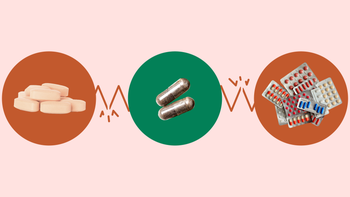
What’s It Like to Take Turmeric Supplements for Arthritis Pain?
Key takeaways:
Turmeric contains curcumin, an anti-inflammatory and antioxidant that may decrease arthritis pain.
It may take a month or two for you to notice any effects from taking turmeric supplements.
In addition to taking turmeric in pill or capsule form, you can also use turmeric in cooking or apply it as a paste.

Steven de Vicente, who manages an accounting operations team for a software company in Huntington Beach, California, has had arthritis for more than a decade.
Steven describes the condition, which also affects both of his parents and is common in his family, as “predatory.” In his case, it’s been especially bad in the hands.
“I have lost a lot of strength in my fingers,” Steven says. “There are times when I can’t pick up a book or a glass without using two hands. And for someone who’s 56, that can be a little troubling.”
Search and compare options
He remembers worrying that his hands would be crippled by his late 60s. But about 3 years ago, his then girlfriend, who’s now his wife, suggested he try taking turmeric supplements. And, over time, he’s found that they help.

“I think it’s a great supplement and really helpful,” Steven says of his overall experience with turmeric. “I think it’s really made a huge difference.”
Turmeric contains curcumin, an anti-inflammatory and antioxidant that may help arthritis and certain other medical issues. Turmeric supplements are best taken with food, especially fatty foods that contain lecithin, such as eggs and vegetable oils like coconut or olive oil. The lecithin in these foods helps the body absorb turmeric. Black pepper also helps the body absorb curcumin, which is why it’s included in many turmeric supplements.
Steven says he didn’t notice an immediate change when he started taking turmeric. But eventually he realized his symptoms were improving.
“It was like a slow burn, and then, all of a sudden, I realized I was doing things,” he says. “Before, I couldn’t pick up things with my hands. Just trying to grab a book off the shelf, that kind of thing — I didn’t have that grip anymore.”
In addition to being able to pick up things, Steven also found that the supplements provided some relief from the pain he’d been experiencing.
“The turmeric has kind of delayed the progression” of the arthritis, he says. “I don’t think it’s ever going to go back to what it was, obviously. But I’m not having that constant, severe pain I was having.”
Read more like this
Explore these related articles, suggested for readers like you.
Steven says he does still have bouts of arthritis flare up, which seem to be weather-related. And if he doesn’t take turmeric for a couple of days, some of the pain in his hands returns.
“I still have moments, but it’s not as bad as it was. I think I’ve improved quite a bit,” he says. “My hands were a lot worse before I started taking the turmeric.”
His mother takes turmeric now, too. But since her arthritis was already pretty advanced, a point that Steven hopes not to reach, her results haven’t been as dramatic as her son’s. That makes Steven feel even more grateful that he has a natural way to help treat his arthritis.
Taking turmeric is “definitely a healthy way to take care of your body without all those chemicals and stuff,” he says. “Not that I’m against medicine. I love medicine — big fan of painkillers and such. But it’s nice to know that there’s something else we can do, too.”
Not a quick fix, but a powerful one
Danielle Siegel, who’s 44 and lives in New Braunfels, Texas, has had arthritis in her knees since she was a teenager.
In the past, she’s been prescribed pain medications because of her arthritis. But she wasn’t able to tolerate them because they caused her intense stomach pain. Eventually, she started cooking with turmeric to help ease her arthritis symptoms. And around 6 years ago, she also started taking daily turmeric capsules.
Based on her experiences, Danielle says it’s important to give the turmeric time to work.
“A doctor I was working with told me, ‘When you have a headache and you take Advil and it helps, does that mean you had an Advil deficiency? No, it means that it was a quick fix,’” she says. “When it comes to turmeric and anything natural, just give it time to work. If you have to do something in the interim, like take Advil, take it — just to give turmeric that time to really work.”
Like Steven, Danielle says she slowly started noticing a difference in her symptoms after a while. At first, she wasn’t in as much pain as often. And then, she noticed a dramatic improvement.
“One day, you wake up and you realize, ‘I can actually jump out of bed!’” she says. “It’s the most unbelievable feeling to feel that. It’s a feeling of, ‘Wow, I didn’t have to be in pain all those years.’ You just feel like you’re back to yourself again. It feels like freedom.”

In addition to taking turmeric in capsule form, Danielle continues to cook with it. And now, she even applies it topically to the bottom of her feet. She makes a paste with turmeric and distilled water, applies it, and then covers her foot with a sock. She lets the paste sit for half an hour and then washes it off.
“Because turmeric stains the skin, I put it in places where you don’t notice it so much,” she says. “The body soaks it up like crazy. It’s amazing.”
In the kitchen, Danielle uses tumeric to spice almost everything. If she’s cooking chicken, she uses it like a dry rub. If she’s making soup, she adds in a healthy amount for seasoning.
“It does turn everything orange,” she says, joking that she has to remind her kids that that means the food is good for them. “I make a chicken soup, which is already kind of yellowish, so they don’t really notice it too much.”
Danielle says turmeric has made a huge difference with her arthritis symptoms, even describing her life since she started taking it as “night-and-day different.”
“When I have a flare-up, it’s hard to even stand up from a low sitting position — things we take for granted,” she says, contrasting that with the fact that she’s now able to do 5Ks and mud runs. “I would not have even been able to go a mile before because it was so painful.”
A traditional Hawaiian remedy
Leilehua Yuen, a 65-year-old artist and kumu hula (hula instructor) in Hilo, Hawaii, has arthritis in her hands, shoulders, spine, and hips.
“As an artist, I depend on my hands for everything from using my tools to dancing hula,” Leilehua says. “On days when my arthritis flares, my hands don’t move, and I can’t pick up my tools. I can’t demonstrate hula moves to my students. I can’t type, and I can’t paint.”
Over the years, doctors have prescribed her painkillers — from over-the-counter acetaminophen (Tylenol) to a prescription opioid called meperidine (Demerol) — for her arthritis. She found unbuffered aspirin to be the most effective against her arthritis pain, but she knew it was problematic to take large dosages.

About 20 years ago, while studying traditional Hawaiian medicine, Leilehua learned about taking turmeric — called ‘ōlena in Hawaiian — for arthritis pain. At that point, she started taking it regularly and discovered that it helped curb her need for other pain relievers.
“I found I could reduce my aspirin consumption by half if I take it with ʻōlena and coconut milk,” she says.
Leilehua grates fresh turmeric root from her own plants into a bowl and adds coconut milk. She also adds ¼ tsp of hyaluronic acid powder, also for arthritis pain, and a bit of honey. If she doesn’t have fresh turmeric root, she uses 1 tsp of turmeric powder from her local supermarket’s spice aisle.
She takes the mixture at night, along with two aspirin, and says it also seems to help her sleep. Sometimes, especially if the weather is cold and damp, she drinks more of the mixture in the morning.
If she gets busy and forgets to take the ‘ōlena, she says, she starts stiffening up again after a few days.
“I think people need to experiment and see what works for them,” Leilehua says. “For me, I don't see any magic bullets. No one thing seems to be a ‘cure.’ But the blend of ʻōlena, hyaluronic acid, and aspirin — combined with exercise, watching my diet to avoid things that aggravate my arthritis, and being mindful of how I move through the world — has me more mobile now at 65 than I was 25 years ago.”
What does the pharmacist say?

Stacia Woodcock, PharmD
Pharmacy Editor
Turmeric is a yellow spice made from the root of the turmeric plant (Curcuma longa). The primary active ingredients in turmeric are curcuminoid compounds, of which curcumin is considered the main one. Turmeric has a long history of medicinal use in China and India, where it’s also a commonly used spice. Studies show that turmeric may help reduce swelling, manage pain, and improve memory. It may also have cancer-fighting and mood-boosting effects.
There’s very little curcumin in turmeric powder, and your body doesn’t absorb curcumin very well from food. So taking supplements that contain turmeric extract (a more concentrated form of curcumin) is an easier way to ensure you’re taking enough curcumin to have an impact on your health.
There isn’t a standard recommended dosage of turmeric, since it isn’t an FDA-approved medication. But most studies use dosages of 500 mg to 2,000 mg of turmeric daily. Keep in mind that turmeric is not the same as curcumin when it comes to recommended dosages. The typical recommended dosage of curcumin is up to 3 mg per kg of body weight daily. This comes to about 200 mg of curcumin daily for a person who weighs 150 lbs.
Common turmeric side effects include diarrhea, headache, and nausea. Doses of more than 500 mg of curcumin are more likely to cause side effects, and doses over 8 gm of curcumin aren’t recommended.
It’s best to avoid turmeric if you’re pregnant or breastfeeding, have a history of kidney stones or gallstones, or if you have diabetes. Turmeric can also interact with several medications, including blood thinners, blood pressure medications, and certain chemotherapy medications. Check with your prescriber to make sure turmeric is safe for you before you start taking it.
Why trust our experts?
































